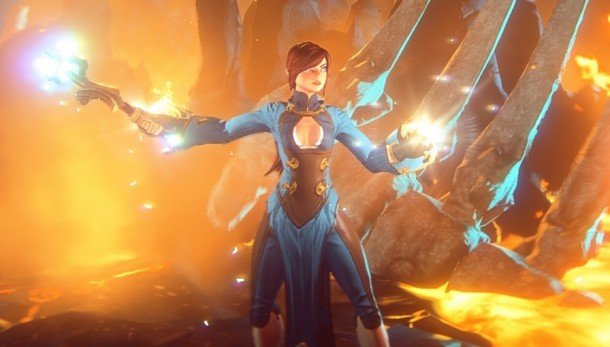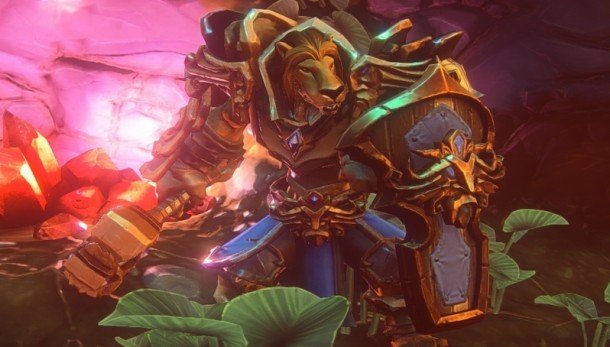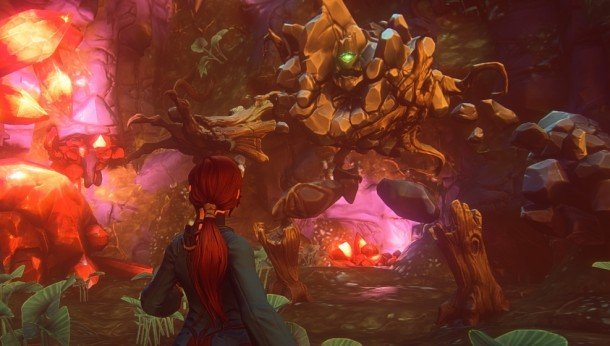Everquest Next first look: a bold, destructible fantasy MMO

I've fallen through the floor in an MMO before. It's not that uncommon – in the worst cases, all you need to do is send a GM a message and they'll relocate you relatively painlessly. As players we generally accept that games break, and that sometimes you'll end up tumbling somewhere you're not supposed to be.
'Tumbling somewhere you're not supposed to be' is part of EverQuest Next's mission statement. SOE's vision for the next generation of MMOs involves a gameworld that is layered like Minecraft, with hand-designed fantasy landscapes on the surface and procedurally-generated tunnels below. The next Norrath is built out of voxels – clever cubelets that can be generated, moulded and destroyed on the fly. At the most basic level, that means a surface world built out of destructible components: demonstrating the game for the first time, game director David Georgeson showed how melee strikes and magic attacks can blow up walls and leave craters.
This is impressive simply as a visual effect, and adds a level of responsiveness to the world that isn't present in other games. Over time, this damage will repair itself to make way for fresh adventurers, and certain key areas won't be destructible at all – but it's what voxel technology has allowed SOE to do next that elevates it from impressive to important.
Break through the floor in EverQuest Next – either in the aftermath of an earth-shattering blow, or by casting a spell or picking up a shovel – and you'll enter a subterranean cavern that is generated on the fly for you to explore. You'll be able to hunt monsters, claim items and conduct the rest of your MMO business in an environment that promises a new experience every time you enter it – and the deeper you go, the more you'll encounter.

As well as differentiating the strata of the world through visual themes – underground lakes, crystal caves, the volcanic core – each layer corresponds to an era in the game's lore, enabling you to encounter history first-hand as you pick through the remains of each passing age.
EverQuest Next is a reboot rather than a sequel. The key characters and places of Norrath will return, but their alignments, appearance and fates have been remixed. The creative freedom this has granted SOE will be extended to the players as well.
Later in the year, SOE will release EverQuest Next Landmark – a freeform voxel-building game where players can claim plots of land, dig for resources, and build whatever they like with them. The obvious inspiration is Minecraft, right down to the random generation of landmasses on every server. Unlike Minecraft, however, Landmark's construction tool allows for the smooth carving of blocks: rough edges are possible, as are curves and even perfect spheres. It's seriously impressive in action, like watching professional 3D software running in a game engine.
The biggest gaming news, reviews and hardware deals
Keep up to date with the most important stories and the best deals, as picked by the PC Gamer team.
Players can then take the things they've made and list them for sale on Player Studio, SOE's take on the Steam Workshop. If you buy one of these prefabs for real money and use them in your own constructions, any money you make will then earn royalties for the original creator. It's Minecraft with microtransactions, where players have the chance to directly benefit. To say that it has the potential to be massive feels like an understatement. The only obstacles I can see are technological, and SOE will be under tremendous pressure to prove that their engine actually works.

The continued development of EverQuest Next will happen in collaboration with Landmark players. Through competitions and events, SOE will allow the community to decide which player-made structures are plucked from their Landmark landmasses and used in the final version of Norrath. Talking to the team about it, ideas spin out rapidly: plaques on temples crediting the player who laid the foundation stones; buildings that cycle between different versions – each made by a different player – each time they're destroyed and rebuilt.
“While not every player is capable of creative genius, there are groups and individuals that are,” says creative director Jeff Butler. “We want to find those people and empower them.”
This spirit of openness will, SOE claim, define the rest of the game's development. I asked art director Rosie Rappaport whether they would ever 'hard code' parts of the environment in ways that players couldn't. “We consider it cheating if we make our own [proprietary] tools,” she says. “That's not our philosophy. We're playing by the same rules that the players are.”
Joining in 2011, Chris made his start with PC Gamer turning beautiful trees into magazines, first as a writer and later as deputy editor. Once PCG's reluctant MMO champion , his discovery of Dota 2 in 2012 led him to much darker, stranger places. In 2015, Chris became the editor of PC Gamer Pro, overseeing our online coverage of competitive gaming and esports. He left in 2017, and can be now found making games and recording the Crate & Crowbar podcast.


